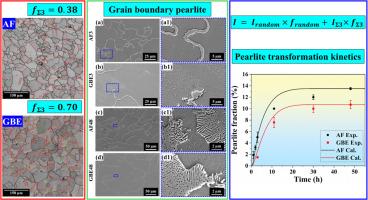Kinetics of pearlite transformation: The effect of grain boundary engineering
IF 8.3
1区 材料科学
Q1 MATERIALS SCIENCE, MULTIDISCIPLINARY
引用次数: 0
Abstract
The present study investigates the effect of grain boundary engineering (GBE) on the pearlite transformation in high-Mn steel. Towards this, as-forged (AF) specimens were thermo-mechanically processed (TMP) to realize GBE microstructure. The electron backscatter diffraction analyses revealed that the GBE specimen exhibit higher fraction of Σ3 and its variant boundaries, larger twin related domain (TRD) size and greater number of grains per TRD than AF and other TMP specimens. Further, isothermal treatment was performed on AF and GBE specimens at 823 K for different time intervals (1 h to 48 h) to understand the kinetics of pearlite transformation. The scanning electron microscope observations revealed that, unlike the AF specimen, the GBE specimen exhibits a significantly lower fraction of grain boundary pearlite after isothermal annealing at 823 K for 3 h. The aforesaid findings are validated using grain boundary nucleation rate calculation by considering the presence of random and Σ3 boundaries. Further, the Johnson-Mehl-Avrami-Kolmogrov model demonstrate that the presence of significant proportion of Σ3 boundaries leads to delay in the overall transformation kinetics of pearlite transformation. Overall, this work highlights that pearlite does not form uniformly on the austenite grain boundaries since it is reluctant to nucleate on low energy special boundaries like the Σ3 boundaries. This retards the overall transformation kinetics in grain boundary engineered steels having a high proportion of special low energy boundaries.


珠光体转变动力学:晶界工程的影响
本文研究了晶界工程(GBE)对高锰钢珠光体转变的影响。为此,对锻造态(AF)试样进行热机械处理(TMP),实现GBE显微组织。电子背散射衍射分析表明,与AF和其他TMP样品相比,GBE样品具有更高的Σ3及其变异边界,更大的孪晶相关畴(TRD)尺寸和每个TRD的晶粒数。此外,对AF和GBE样品在823 K下进行不同时间间隔(1 h至48 h)的等温处理,以了解珠光体转变的动力学。扫描电镜观察显示,与AF样品不同,GBE样品在823 K等温退火3小时后,晶界珠光体的比例明显降低。通过考虑随机和Σ3边界的存在,计算晶界成核率,验证了上述发现。此外,Johnson-Mehl-Avrami-Kolmogrov模型表明,Σ3边界的显著比例的存在导致珠光体转变的整体转变动力学延迟。总的来说,这项工作强调了珠光体在奥氏体晶界上不均匀形成,因为它不愿在像Σ3晶界这样的低能特殊晶界上成核。这阻碍了具有高比例特殊低能边界的晶界工程钢的整体转变动力学。
本文章由计算机程序翻译,如有差异,请以英文原文为准。
求助全文
约1分钟内获得全文
求助全文
来源期刊

Acta Materialia
工程技术-材料科学:综合
CiteScore
16.10
自引率
8.50%
发文量
801
审稿时长
53 days
期刊介绍:
Acta Materialia serves as a platform for publishing full-length, original papers and commissioned overviews that contribute to a profound understanding of the correlation between the processing, structure, and properties of inorganic materials. The journal seeks papers with high impact potential or those that significantly propel the field forward. The scope includes the atomic and molecular arrangements, chemical and electronic structures, and microstructure of materials, focusing on their mechanical or functional behavior across all length scales, including nanostructures.
 求助内容:
求助内容: 应助结果提醒方式:
应助结果提醒方式:


